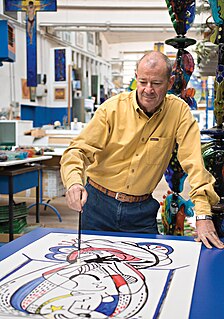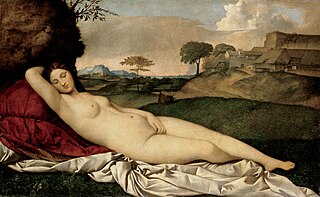
Ugo Nespolo is an Italian artist. Painter, sculptor, film-maker, journalist. Irony and play are how he expresses his creative eclectic language, rich in cultural references. He lives and works in Turin.

Giorgio Vasari was an Italian painter, architect, engineer, writer, and historian, best known for his Lives of the Most Excellent Painters, Sculptors, and Architects, considered the ideological foundation of art-historical writing, and the basis for biographies of several Renaissance artists, including Leonardo da Vinci and Michelangelo. Vasari designed the Tomb of Michelangelo in the Basilica of Santa Croce, Florence that was completed in 1578. Based on Vasari's text in print about Giotto's new manner of painting as a rinascita (rebirth), author Jules Michelet in his Histoire de France (1835) suggested adoption of Vasari's concept, using the term Renaissance to distinguish the cultural change. The term was adopted thereafter in historiography and still is in use today.

Murano is a series of islands linked by bridges in the Venetian Lagoon, northern Italy. It lies about 1.5 kilometres north of Venice and measures about 1.5 km (1 mi) across with a population of just over 5,000. It is famous for its glass making. It was once an independent comune, but is now a frazione of the comune of Venice.

Santa Maria della Salute, commonly known simply as the Salute, is a Roman Catholic church and minor basilica located at Punta della Dogana in the Dorsoduro sestiere of the city of Venice, Italy.

San Giorgio Maggiore is one of the islands of Venice, northern Italy, lying east of the Giudecca and south of the main island group. The island, or more specifically its Palladian church, is an important landmark. It has been much painted, featuring for example in a series by Monet.

Venetian glass is glassware made in Venice, typically on the island of Murano near the city. Traditionally it is made with a soda-lime "metal" and is typically elaborately decorated, with various "hot" glass-forming techniques, as well as gilding, enamel, or engraving. Production has been concentrated on the Venetian island of Murano since the 13th century. Today Murano is known for its art glass, but it has a long history of innovations in glassmaking in addition to its artistic fame—and was Europe's major center for luxury glass from the High Middle Ages to the Italian Renaissance. During the 15th century, Murano glassmakers created cristallo—which was almost transparent and considered the finest glass in the world. Murano glassmakers also developed a white-colored glass that looked like porcelain. They later became Europe's finest makers of mirrors.

The Wedding Feast at Cana, by Paolo Veronese, is a representational painting that depicts the biblical story of the Marriage at Cana, at which Jesus miraculously converts water into red wine. Executed in the Mannerist style (1520–1600) of the late Renaissance, the large-format oil painting comprehends the stylistic ideal of compositional harmony, as practised by the artists Leonardo, Raphael, and Michelangelo.

Saint-Georges majeur au crépuscule refers to an Impressionist painting by Claude Monet, which exists in more than one version. It forms part of a series of views of the monastery-island of San Giorgio Maggiore. This series is in turn part of a larger series of views of Venice which Monet began in 1908 during his only visit there.

The San Giorgio Monastery was a Benedictine monastery in Venice, Italy, located on the island of San Giorgio Maggiore. It stands next to the Church of San Giorgio Maggiore, which serves the monastic community. The old monastic buildings currently serves as the headquarters of the Cini Foundation.

San Giorgio Maggiore is a 16th-century Benedictine church on the island of the same name in Venice, northern Italy, designed by Andrea Palladio, and built between 1566 and 1610. The church is a basilica in the classical Renaissance style and its brilliant white marble gleams above the blue water of the lagoon opposite the Piazzetta di San Marco and forms the focal point of the view from every part of the Riva degli Schiavoni.

Lino Tagliapietra is a Venetian glass artist who has also worked extensively in the United States. As a teacher and mentor, he has played a key role in the international exchange of glassblowing processes and techniques between the principal American centers and his native Murano, "but his influence is also apparent in China, Japan, and Australia—and filters far beyond any political or geographic boundaries."
Matteo Ponzone was an Italian painter of the Baroque period, active between 1630 and 1700 mainly in Venice. He was a pupil of Santo Peranda. Several of his works are in the churches and public buildings of Venice, particularly in San Giorgio Maggiore, and in the church of the "Padri Croceferi".

Silvio Vigliaturo was born in Acri (Cosenza), in 1949. When still a child he moved to Chieri (Turin), where presently he lives and works. He is a glassfusion maestro and his technique is appreciated internationally and considered unique in his genre by the most important Italian and foreign critics.

Pauly & C. - Compagnia Venezia Murano is one of the most ancient glass factory of Murano: it was founded more than 150 years ago. This company produces glass art, most notably Roman murrine, mosaics and chandeliers.

Ferruccio Bortoluzzi was an Italian modern painter, he was one of the founders of the Centro di Unità della Cultura L'Arco together with venetian artists and writers.

Pae White is an American multimedia visual artist who is known for her unique portrayal of nature and rather mundane objects through her creations of suspended mobiles. She currently lives and works between Sonoma County and Los Angeles, California.

The Seguso family has been dedicated to the art of Murano glass in Venice since May 3, 1397. Seguso is one of the most esteemed, historical and respected glass manufacturers on the island, and among the largest glass furnaces in Murano, which has a few, homonymous furnaces. Glass made by the Seguso furnace can be found in over 75 museums worldwide, such as MOMA in New York and the Victoria and Albert Museum in London. Today, Seguso is known for its high end Venetian glass objects, lighting, accessories and custom installations. Seguso glass has been made for the Pope, Royalty and numerous luxury interiors throughout the world.
William Warmus is a curator, art critic, and author focusing on transparent media.

The Doge's Palace Seen from San Giorgio Maggiore is a 1908 painting by Claude Monet. It is currently in the collection of the Metropolitan Museum of Art. This painting, catalogued W1755, is one of six versions of this scene painted by Monet in 1908. Other versions are held by the Kunsthaus Zürich, and the Solomon R. Guggenheim Museum.

The Venetian Renaissance had a distinct character compared to the general Italian Renaissance elsewhere. The Republic of Venice was topographically distinct from the rest of the city-states of Renaissance Italy as a result of their geographic location, which isolated the city politically, economically and culturally, allowing the city the leisure to pursue the pleasures of art. The influence of Venetian art did not cease to continue at the termination of the Renaissance period. Its practices persisted through the works of art critics and artists proliferating its prominence around Europe to the 19th century.


















